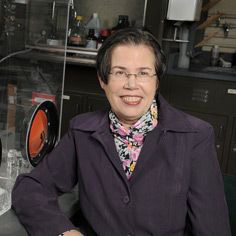Membrane structure and interactions with diffuse x-ray scattering
 I study membrane structure at 1 angstrom resolution using synchrotron x-ray diffuse scattering. Fully hydrated fluid-phase membranes, such as those in the human body, pose experimental structural problems due to disorder and fluctuations. These challenges are overcome by preparing oriented stacks of membranes hydrated to their full complement of water though the vapor. When x-rayed, fluctuating membranes produce diffuse lobes of low-angle intensity that yield both structure and material properties. Structural results are membrane thickness and area, and location of additives such as bioflavinoids, cholesterol and peptides, and, in several cases, these results are confirmed by collaborative membrane simulations. Material properties include the bending modulus (KC), which is an indicator of membrane stiffness. The same samples also produce wide-angle x-ray scattering which yields a membrane order parameter. My recent results have focused on the interaction of HIV peptides with membranes mimicking the HIV virion membrane and the T-cell membrane. I found that the FP23 fusion peptide from HIV gp41 has the ability to dramatically lower KC of a T-cell membrane mimic, thus lowering the energy required to form highly curved membrane intermediates during HIV infection. Similarly, the CRAC-motif peptide LWYIK which binds cholesterol and is located at the MPER (membrane proximal ectodomain region) of the HIV virion, also lowers KC. Both of these peptides locate near the headgroup region and thin their membranes, suggesting a mechanism by which they participate in HIV/T-cell fusion. My HIV results have been published in Biophys J, BBA, J Mol Biol, and earlier work in Phys Rev Lett, PNAS, JACS, J Phys Chem B (cover), J Lipid Res, Chem Phys Lipids, Langmuir, J Memb Biol, Phys Rev E, Biochemistry, Biophys J and BBA. My present research focus has shifted to the study of antimicrobial peptides due to the increase in bacterial resistance to current antibiotics. My group is currently studying colistin, and several newly engineered Cationic Antimicrobial Peptides (eCAPs) using both diffuse X-ray scattering techniques and circular dichroism.
I study membrane structure at 1 angstrom resolution using synchrotron x-ray diffuse scattering. Fully hydrated fluid-phase membranes, such as those in the human body, pose experimental structural problems due to disorder and fluctuations. These challenges are overcome by preparing oriented stacks of membranes hydrated to their full complement of water though the vapor. When x-rayed, fluctuating membranes produce diffuse lobes of low-angle intensity that yield both structure and material properties. Structural results are membrane thickness and area, and location of additives such as bioflavinoids, cholesterol and peptides, and, in several cases, these results are confirmed by collaborative membrane simulations. Material properties include the bending modulus (KC), which is an indicator of membrane stiffness. The same samples also produce wide-angle x-ray scattering which yields a membrane order parameter. My recent results have focused on the interaction of HIV peptides with membranes mimicking the HIV virion membrane and the T-cell membrane. I found that the FP23 fusion peptide from HIV gp41 has the ability to dramatically lower KC of a T-cell membrane mimic, thus lowering the energy required to form highly curved membrane intermediates during HIV infection. Similarly, the CRAC-motif peptide LWYIK which binds cholesterol and is located at the MPER (membrane proximal ectodomain region) of the HIV virion, also lowers KC. Both of these peptides locate near the headgroup region and thin their membranes, suggesting a mechanism by which they participate in HIV/T-cell fusion. My HIV results have been published in Biophys J, BBA, J Mol Biol, and earlier work in Phys Rev Lett, PNAS, JACS, J Phys Chem B (cover), J Lipid Res, Chem Phys Lipids, Langmuir, J Memb Biol, Phys Rev E, Biochemistry, Biophys J and BBA. My present research focus has shifted to the study of antimicrobial peptides due to the increase in bacterial resistance to current antibiotics. My group is currently studying colistin, and several newly engineered Cationic Antimicrobial Peptides (eCAPs) using both diffuse X-ray scattering techniques and circular dichroism.
Education
PhD 1981, University of California, Berkeley
Postdoctoral Training
Carnegie Mellon University, Membrane Structure and Thermodynamics, Department of Biological Science
Carnegie Mellon University
Physics Department
6415 Wean Hall
5000 Forbes Avenue
Pittsburgh, PA 15213
Phone: (412) 268-3174
Fax: (412) 681-0648
E-mail: stn@cmu.edu
Visit website

